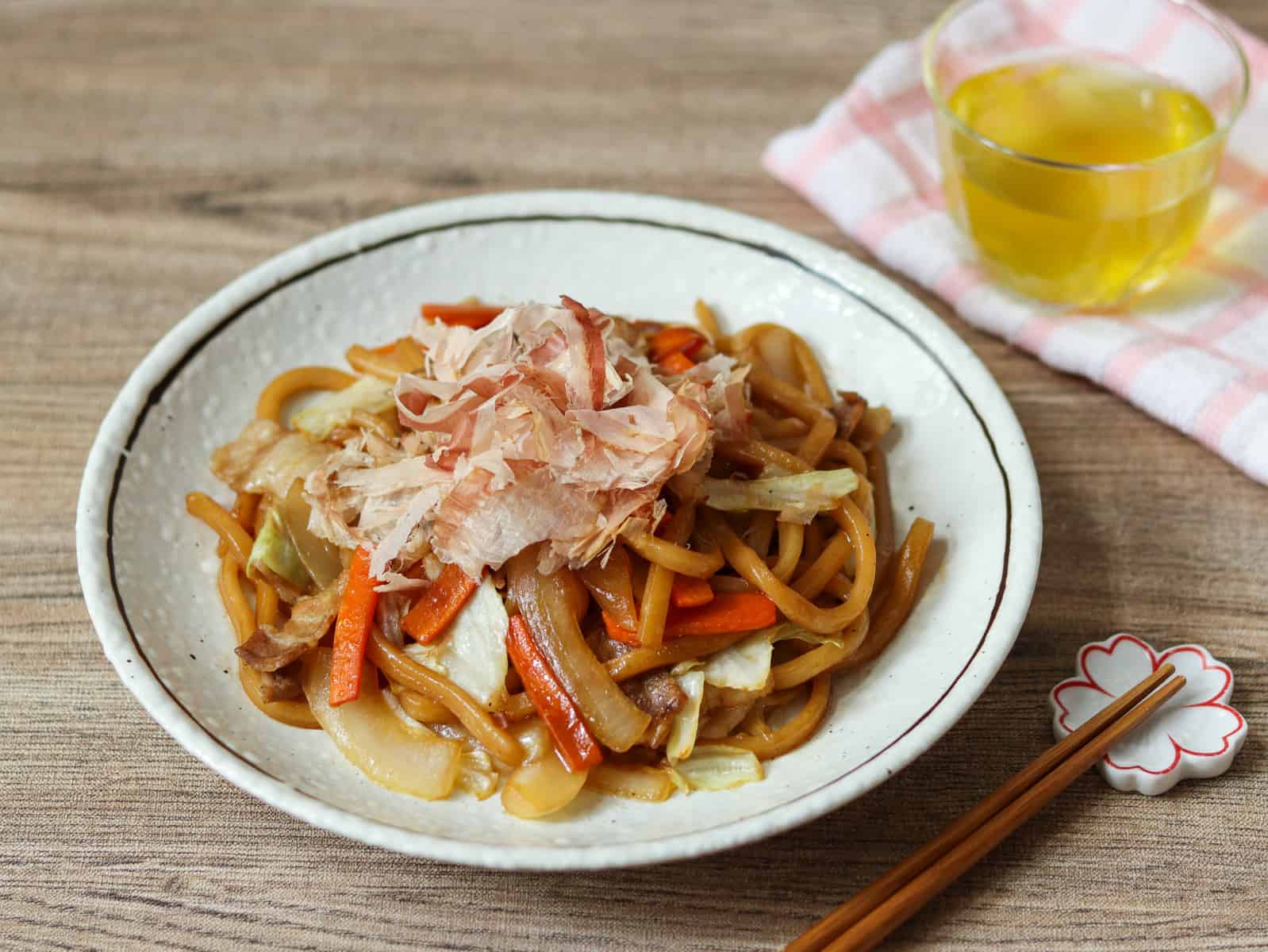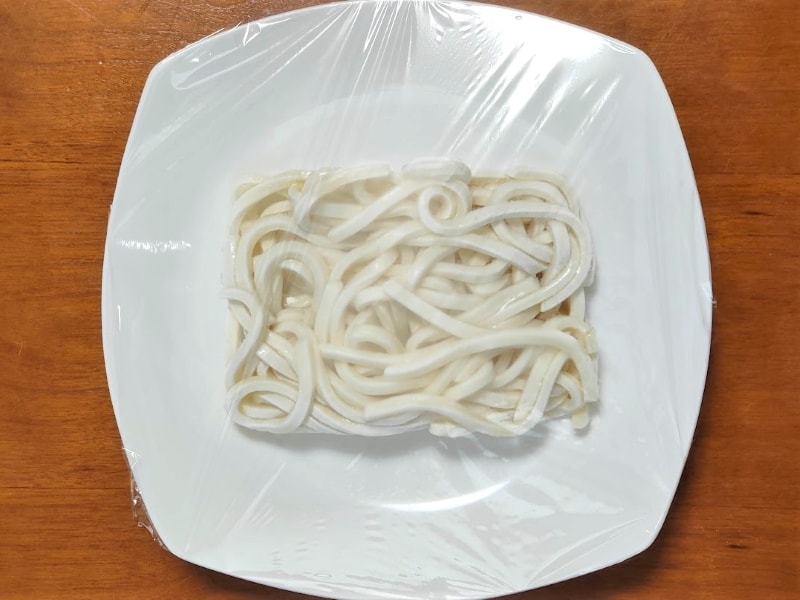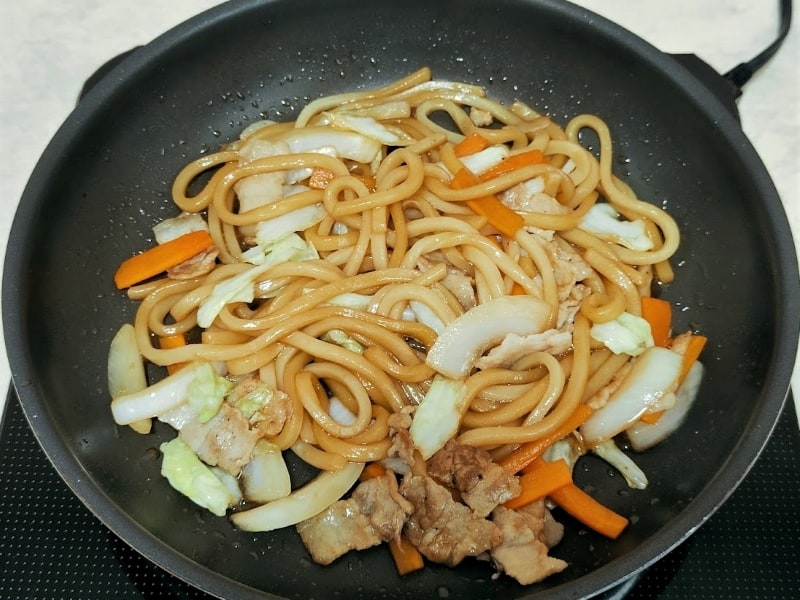Yaki Udon, Japanese stir-fried udon noodles seasoned with soy sauce and bonito flakes, has an addictive charm once you have tried it. Unlike udon noodle soup, it contains no broth, which allows you to enjoy the noodles from a completely different perspective.

Jump to:
What is Yaki Udon?
Yaki Udon is a Japanese dish made with boiled udon noodles that are stir-fried with protein and vegetables. "Yaki" means stir-fried, and "Udon" refers to udon noodles. It is typically seasoned with soy sauce and bonito flakes (katsuobushi).
The savory flavor of soy sauce coats the udon noodles, while bonito flakes add a distinctive aroma to the dish. Not only does it offer a well-balanced meal on its own, but it also captures the true essence of Japanese cuisine. If you are a fan of udon, this is definitely a dish you should try.
Protein options
There are many different proteins that can be used in this dish. Pork, beef, and seafood are all common choices, but pork belly is by far the most popular. It adds depth and richness to the udon noodles and vegetables, enhancing the overall flavor of the dish. I also use pork belly in this recipe.
If you are using other types of meat or seafood, such as shrimp, squid, or scallops, each brings its own distinct flavor that sets it apart from pork belly. The choice of protein can change the overall impression of the dish, so after enjoying it as written in the recipe, try making it with other proteins as well for a different taste experience.
Vegetable choices
Let's also take a look at the vegetables commonly used in yaki udon. Some of the vegetables often included in this dish are:
- Carrots
- Onions
- Green cabbage
- Green bell peppers
- Naganegi (Japanese leeks)
- Garlic chives
The recipe calls for carrots, cabbage, and onions, but feel free to use any vegetables you like. Try choosing vegetables that will add both color and nutrition to the dish. You could also have fun experimenting with local specialty vegetables from your area.
Yaki Udon vs. Yakisoba
One Japanese dish that uses ingredients similar to those in yaki udon is yakisoba. Yakisoba is made by stir-frying Chinese-style noodles instead of udon noodles, and it is said that yaki udon was originally created when yakisoba noodles were out of stock and udon noodles were used as a substitute.
That said, the flavors of the two dishes are now quite different. While yakisoba is usually flavored with a Worcestershire-based sauce, yaki udon is typically seasoned with soy sauce and bonito flakes. I'm confident in my yakisoba recipe, but I think yaki udon is just as delicious.
Yakisoba is more widely known, but yaki udon has a flavor that feels more traditionally Japanese. Try both and taste the difference for yourself.

📋Step-by-step recipe
Ingredients
- 1 serving udon noodles (fresh, dried, pre-cooked, or frozen)
- 2 oz thinly sliced pork belly
- 1 oz carrot
- 1 oz onion
- 2 oz green cabbage
- a pinch of salt (for the pork)
- a pinch of ground black pepper (for the pork)
- 1 Tbsp shaved bonito flakes (katsuobushi)
Seasonings:
- 1 Tbsp sake
- ½ Tbsp mirin
- 1 ½ Tbsp soy sauce
Instructions
🕒 Total: 20 mins
Step 1
If using fresh, dried, or pre-cooked udon noodles: Boil the udon noodles according to the package instructions. Once cooked, drain them in a colander.
If using frozen udon noodles: Lightly sprinkle water over the udon noodles. Then, place them on a microwave-safe plate, cover with plastic wrap or a microwave-safe lid, and microwave on medium power (500-600W) for 3.5 to 4 minutes, or until heated through. (Since this method can cause uneven heating, it is best to microwave one serving at a time. You can also boil them like the other types of udon noodles.)

Step 2
Cut the carrot and onion into long, thin, bite-sized pieces. Tear the cabbage into bite-sized pieces. Cut the pork belly into pieces about ⅗ inch (1.5 cm) wide.

Step 3
In a small bowl, mix the seasonings (sake, mirin, and soy sauce).

Step 4
Heat oil in a pan. Once the pan is hot, add the pork, sprinkle with salt and black pepper, and sauté until it changes color. Then, add the vegetables in order of firmness (carrot, onion, and cabbage), and stir-fry until tender.

Step 5
Push the stir-fried ingredients to one side of the pan and add the udon noodles to the empty space. Pour the seasoning mixture from the small bowl over the noodles and mix well. Once the noodles are evenly coated with the seasoning, stir to combine them with the other ingredients. Then, cover the pan with a lid and let it steam over low heat for 2 minutes.

Step 6
Remove the lid and continue cooking until most of the remaining moisture has evaporated.

Step 7
Serve on a plate and sprinkle bonito flakes on top.
To store
You can store it in the refrigerator for up to 2 days. However, it is best to eat it as soon as possible because the moisture in the udon noodles evaporates over time, causing them to dry out.

If you try this recipe, I’d love to hear what you think. Please consider leaving a review and star rating in the comments below. If you enjoyed it, I’d really appreciate it if you shared it with your friends.
More recipes you'll love
Recipe card

Yaki Udon (Japanese Stir-Fried Udon Noodles)
Ingredients
- 1 serving udon noodles (fresh, dried, pre-cooked, or frozen)
- 2 oz thinly sliced pork belly
- 1 oz carrot
- 1 oz onion
- 2 oz green cabbage
- a pinch of salt (for the pork)
- a pinch of ground black pepper (for the pork)
- 1 Tbsp shaved bonito flakes (katsuobushi)
Seasonings:
- 1 Tbsp sake
- ½ Tbsp mirin
- 1 ½ Tbsp soy sauce
Instructions
- If using fresh, dried, or pre-cooked udon noodles: Boil the udon noodles according to the package instructions. Once cooked, drain them in a colander.If using frozen udon noodles: Lightly sprinkle water over the udon noodles. Then, place them on a microwave-safe plate, cover with plastic wrap or a microwave-safe lid, and microwave on medium power (500-600W) for 3.5 to 4 minutes, or until heated through. (Since this method can cause uneven heating, it is best to microwave one serving at a time. You can also boil them like the other types of udon noodles.)
- Cut the carrot and onion into long, thin, bite-sized pieces. Tear the cabbage into bite-sized pieces. Cut the pork belly into pieces about ⅗ inch (1.5 cm) wide.
- In a small bowl, mix the seasonings (sake, mirin, and soy sauce).
- Heat oil in a pan. Once the pan is hot, add the pork, sprinkle with salt and black pepper, and sauté until it changes color. Then, add the vegetables in order of firmness (carrot, onion, and cabbage), and stir-fry until tender.
- Push the stir-fried ingredients to one side of the pan and add the udon noodles to the empty space. Pour the seasoning mixture from the small bowl over the noodles and mix well. Once the noodles are evenly coated with the seasoning, stir to combine them with the other ingredients. Then, cover the pan with a lid and let it steam over low heat for 2 minutes.
- Remove the lid and continue cooking until most of the remaining moisture has evaporated.
- Serve on a plate and sprinkle bonito flakes on top.
Notes
- You can store it in the refrigerator for up to 2 days. However, it is best to eat it as soon as possible because the moisture in the udon noodles evaporates over time, causing them to dry out.












Leave a Rating and a Comment